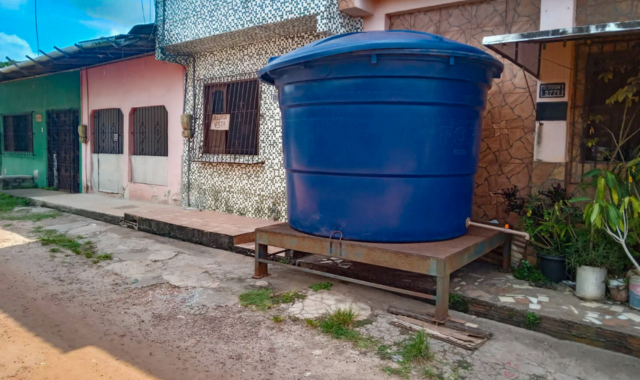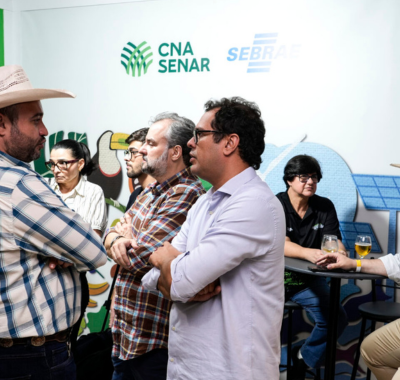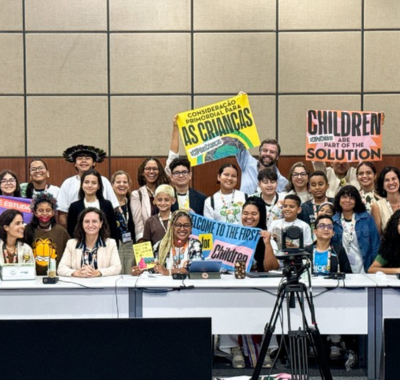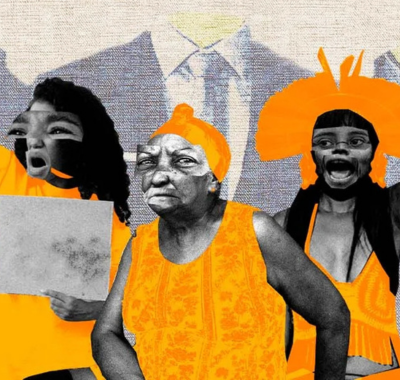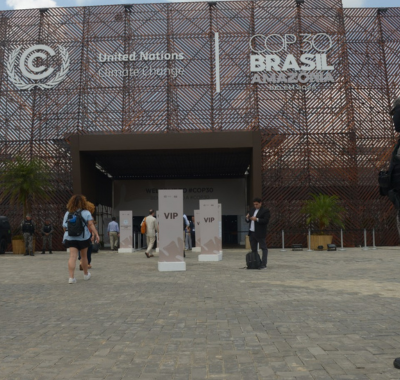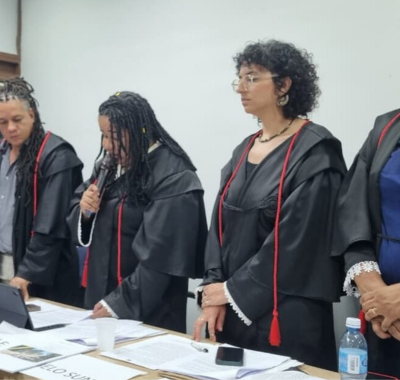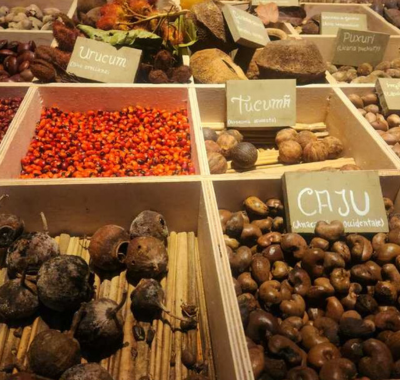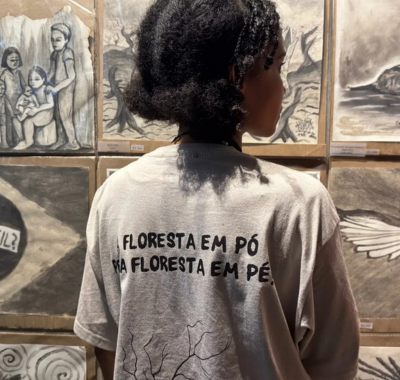By: Adriana Amâncio, Alice Martins, and Athila Galindo
Editing: Bruno Fonseca
Resident of the São João do Outeiro neighborhood, in the northern part of Belém, librarian Rosilda Santana, 60, says that in the three decades she has lived there, she has never had regular running water. “Water comes twice a week — no one knows when, no one knows what time,” she explains. At times, she and her neighbors have had to collect water from a large tank placed in the middle of the street, refilled by water trucks.
Santana, a Black woman, embodies the demographic and racial reality of Belém, host city of COP30: neighborhoods with higher Black populations have less access to running water and basic sanitation. The findings come from an analysis by Agência Pública, based on data from the Brazilian Institute of Geography and Statistics (IBGE).
According to the 2022 Census, São João do Outeiro has a population of 11,057, of which 5,604 are women — just over half. Among them, the vast majority (4,377) identify as Black or mixed-race. The average monthly income of household heads is R$ 1,410, and only 55.6% of residents have access to the public water supply network.
With 1.3 million inhabitants and a GDP of R$ 33.4 billion, the capital of Pará still has 58,000 people without access to drinking water and 1 million without sewage systems, according to a study by the NGO Mandi.
Sanitation coverage is mostly concentrated in the southern neighborhoods — areas where residents have higher average incomes. These are also the neighborhoods where a greater proportion of people identify as white, compared to other parts of the city.
What Does COP30 Have to Do with This?
One of the main goals of the conference is to establish guidelines for climate adaptation, addressing changes that are already underway. Access to water, basic sanitation, and waste collection are fundamental for communities to withstand heat waves, floods, and other extreme events, helping prevent deaths, disease, and other problems that will intensify with the climate crisis.
Black communities are among the most directly affected and vulnerable to these changes — and should be prioritized when it comes to adaptation solutions.
Water Shortages in Belém: The Bill Arrives, But the Water Doesn’t
Until last year, Santana’s daily routine included carrying bucket after bucket of water with her husband to supply their home. “A neighbor used to have an open well, and we’d get water from her tap until I finally managed to build my own artesian well,” she recalls.
The time she spent fetching water was compounded by a long commute to work: Santana travels two hours round-trip to her job at the Scientific Police of Pará, in the Bengui neighborhood, 18 kilometers from where she lives. “Just waiting for the bus takes about 40 minutes,” she laments.
To dig their own well, Santana and her husband had to spend R$ 2,000. The system includes a pump to bring water to the taps on days when the public supply fails.
Since the privatization of water services and the concession to Águas do Pará in September 2025, Rosilda says the situation has become even more complicated. “Now that it’s privatized, they want to charge us. The funny thing is, they came to my house to collect a bill even though no water comes out of my tap. The bill says R$ 54, but the tap is dry,” she complains.
Rosilda explains that, although she has pipes and faucets installed, she never received water through the public network, so she previously didn’t pay for the service. Now, she says she is “outraged to be paying for a service that only works two days a week.”
In a statement to Agência Pública, Águas do Pará said it aims to reach 99% water supply coverage, serving 5 million people across Pará by 2033. “The company will give special attention to vulnerable communities, with plans to offer a Social Tariff to 1.6 million residents — about 30% of the population,” the company added.
According to Águas do Pará, the water tariff is calculated based on household consumption; for homes without meters, rates are set by the Pará State Regulatory Agency (Arcon) according to the customer’s consumption category. “The goal is for every home to have an individual water meter,” the company stated.
Águas do Pará took over operations in Belém, Ananindeua, and Marituba in September 2025 and has been investing R$ 220 million, primarily to improve water regularity and quality — including cleaning more than 30 wells, such as the one in Outeiro.
2.5 km from a Multimillion-COP Project, a Baker Faces a Forgotten Street
Jhulya Souza, 31, is a baker who lives on an unpaved street without sewage in Campina de Icoaraci, another neighborhood in northern Belém. She studied, specialized, and built up a clientele — but the environment discourages her from growing her business. “Long-time residents say the street was only paved once. When it rains, the ditch fills up and people get stranded,” she says.
Her house is 15 minutes from the Augusto Montenegro highway and just 2.5 km from the new Outeiro Port Terminal — a R$ 260 million project funded by the federal government through Itaipu Binacional and carried out by Companhia Docas do Pará (CDP) to host cruise ships during COP30. Meanwhile, the nearest bus stop is 1.2 km away, and ride-hailing drivers avoid the area. “Sometimes we have to wade through water. Sometimes a neighbor helps and gives us a ride,” she says.
Improvised sewage causes bad smells and affects her work. “It’s hard to deliver orders — sometimes we can’t even take new ones. You have to balance everything so the cakes don’t fall apart in the car,” she says.
She adds that tap water often comes out dirty, forcing her to buy filters. Jhulya once studied pedagogy at the Federal University of Pará (UFPA) but had to pause when her daughter was born. Now she divides her time between baking and caregiving. “My dream is to live from my bakery. At first, I had more clients, but delivery costs just don’t make it worth it,” she admits.
She criticizes the city’s priorities. “It’s fine to spend all that money on a park downtown, but they should look at other neighborhoods too — otherwise, they’re just covering up Belém’s problems,” she says.
In Campina de Icoaraci, where Jhulya lives, sewage coverage is extremely low. The neighborhood has 23,023 inhabitants, most of them women (12,037). Among them, 9,279 identify as Black or mixed-race. Only 15.5% of the population has access to sewage services, and the average household head income is R$ 1,952.43.
According to Lígia Paz, Environmental and Sanitary Engineer and coordinator at NGO Mandi, “the map shows that most sanitation investments in Belém exclude the outskirts, lowlands, and vulnerable areas — mostly inhabited by Black and low-income residents. Within this group, gender further deepens vulnerability, especially for women,” she stresses.
Water and Sanitation Shortages: A Historic Problem in the Belém Metropolitan Area
The lack of sanitation in Brazil is a long-standing issue. According to the Trata Brasil Institute’s ranking, Belém has been among the 13 worst municipalities in the country for sanitation over the past decade. Other cities in the same state, such as Santarém and Ananindeua, also rank among the 20 worst.
For Lígia Paz, this deficit in sanitation services reflects “the lack and inefficiency of public policies that integrate housing, urban planning, the right to the city, gender, race, class, sanitation, and climate,” she explains.
The engineer adds that “the root of the sanitation crisis in the Amazon region, especially in Belém, lies in the historical structural inequalities embedded in Brazil’s development model. The Amazon has always been treated as a territory for resource extraction — from our waters to our forests — and not as a territory with rights,” she asserts.
Garbage collection follows the same pattern as sewage services — concentrated in Belém’s southern neighborhoods and becoming scarcer toward the north. Census data shows that while waste collection rates exceed 97% in the south, they fall below 76% in some northern neighborhoods.
Few know the burden of this problem better than Jéssica Teixeira, 32, a resident of Quilombo do Abacatal, located in the Aurá neighborhood on Belém’s eastern edge. Having experienced childbirth at home, she recalls the flood of worries that come with it: colic, postpartum pain, new routines, expenses. For Black women in the outskirts, these are compounded by the stress of lacking basic sanitation. “It’s not just buying diapers — you have to think about where to throw the trash, since collection doesn’t reach here,” she says.
Aurá has a small population — only 2,009 residents, most of them women (1,041), and about 42.3% identify as Black. The average household head earns R$ 1,282, and 73.5% of residents have access to waste collection.
Even though Teixeira lives next to the metropolitan landfill, the nearest garbage collection point is 9 km away. “During my first pregnancy, we started collecting our trash and taking it to where the selective waste truck passed, but people there often insulted us,” she recalls.
Owner of a small family restaurant, she faces the effects of poor sanitation every day. “Sewage still runs in open ditches, with no connection to treatment systems. And because we depend on wells, tests have found fecal contamination in two of them,” she reports.
Her routine is relentless: she wakes up at 4:30 a.m., prepares coffee for a company client, takes her children to school, cooks for the restaurant, studies accounting at night at UFPA, and still looks after her family. “It’s the women who stay home and care for everyone. They’re the ones walking long distances for water and dealing with intimate hygiene problems because there’s no proper bathroom,” she points out.
Women are also the ones coming up with solutions. Some work in recycling and try to manage waste disposal on their own. “Still, most trash ends up being burned or buried,” she says. Teixeira places her hope in younger generations through education: “My son took a composting class at school. He brought the idea home, and now we have compost bins and are studying how to install a biodigester — all thanks to him,” she shares.

